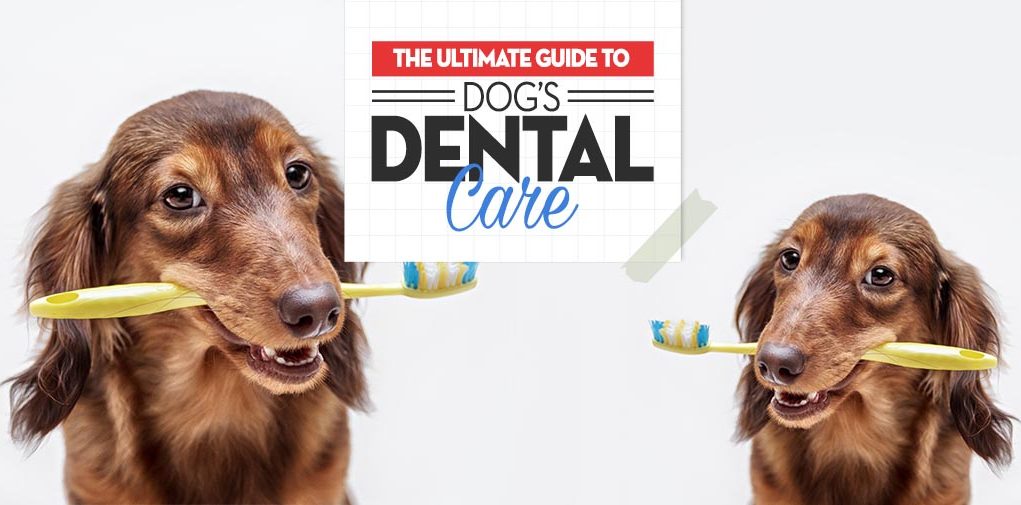Table of Contents
- The Ultimate Guide to Dog Dental Care
- Frequently Asked Questions
- 1. Do dogs get cavities?
- 2. Do dogs regrow lost adult teeth?
- 3. Why do I have to have baby teeth removed if my dog is older than 8 months?
- 4. What is that huge tooth called?
- 5. Does my dog have to have pre-cleaning x-rays?
- 6. Why do small dogs have so much trouble with their teeth?
- 7. Do dogs have to be anesthetized for a professional dental cleaning?
- 8. Isn’t anesthesia dangerous for my dog?
- 9. How much does a professional dental cleaning for dogs cost?
- 10. Do dogs get root canals or crowns?
- 11. Do I really have to brush my dog’s teeth?
Y
our dog’s overall health is dependent on many factors, including his dental hygiene. Not only improper dog dental care and hygiene can result in pain, gum disease, and tooth loss for your dog, but it also increases the risk of heart disease and malnutrition in canines. In short, if you don't keep up with your dog's dental hygiene, it could shorten his lifespan.
In this article, I will walk you through step by step on how to best care for dog's teeth, why you should do so, and how to save time and money on daily dog dental care.
The problem is much too common
Periodontal disease in dogs is much more common than pet owners realize. Unfortunately, when veterinarians recommend tooth brushing and regular dental cleanings, owners do not listen. A lot of us don't want to take the time to brush our dogs' teeth everyday or spend the extra money to bring him in for cleanings every 6-12 months.
Little do many pet owners realize, a few minutes every day and a couple hundred dollars spent on vet bills each year could add years to their dog's life. Not only that, but proper dog's dental hygiene could save you thousands of dollars on medical treatment for conditions caused by poor dental health.
According to the American Veterinary Dental College (AVDC):
“Periodontal disease is the most common clinical condition occurring in adult dogs and cats, and is entirely preventable. By three years of age, most dogs and cats have some evidence of periodontal disease. Unfortunately, other than bad breath, there are few signs of the disease process evident to the owner, and professional dental cleaning and periodontal therapy often comes too late to prevent extensive disease or to save teeth.”
There are several signs that may indicate that your dog is experiencing poor dental health or dental trouble, and the most common include:
- Bad breath or “doggy breath.”
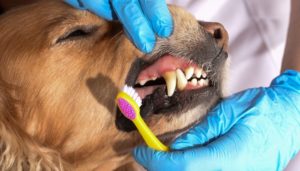
- Pawing at the mouth
- Reluctance to eat
- Reluctance to eat on one side of the mouth
- Rubbing the mouth on the floor
- Swelling, heat, or redness in the mouth
These signs may indicate any number of dental problems, including an abscess, a broken/chipped tooth, fractured roots, a foreign object stuck in the mouth, a sore in the mouth, or excessive plaque buildup. If you notice any of these signs, you need to take your dog in for an exam with your veterinarian as soon as possible.
Now, below is everything you need to know about proper dog dental care.
ALSO READ: The Best Dog Dental Treats & Chews
The Ultimate Guide to Dog Dental Care
1 Different Age – Different Care
Depending on how old your dog is, you will need to practice different dog dental care. Puppy teeth care in particular differs from adult or senior dogs because they're going through teething and otherwise have their teeth formed for the first weeks of their life.
Your Puppy’s Teeth
Puppies are born without any teeth, but by 10-weeks old they have 28 “milk” teeth. These milk teeth fall out between 4 and 6-months old and are replaced by 42 adult teeth. Between 7 and 8-months old, a puppy should have a full set of adult teeth.
While puppy teeth can be very sharp, it’s important to get your puppy used to having his mouth touched. Begin handling his muzzle when they are young. Once your puppy gets used to having his mouth touched, begin brushing his teeth.
While your puppy’s milk teeth are going to fall out, it’s much easier to brush an adult dog’s teeth when he has been desensitized to tooth brushing at a young age.
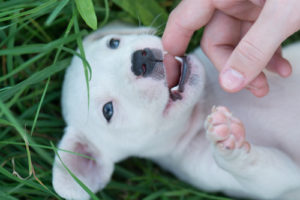 Once a puppy is weaned from their mother, he will already have begun growing his milk teeth. By the time your puppy comes home, he will have most (if not all) of his milk teeth.
Once a puppy is weaned from their mother, he will already have begun growing his milk teeth. By the time your puppy comes home, he will have most (if not all) of his milk teeth.
It won’t be long after your puppy comes home that they begin losing their milk teeth. Not only will you find these small rice-sized teeth around your home, but you will also notice that your puppy may have bad breath. This is normal.
As your puppy’s milk teeth are falling out and their adult teeth are coming in, they will need chew toys to relieve teething pain. Freezable toys are particularly helpful for relieving pain and swelling.
Your Adult Dog's Teeth
Between 6 and 8 months, your puppy should have all of their adult teeth. Keep an eye on your puppy’s adult teeth as they come in. If your puppy still has its baby teeth after 8 months, consult your vet about removal.
Once your dog has a full set of 42 adult teeth, it’s important to maintain regular dental hygiene to keep these teeth healthy. Keep in mind that healthy teeth will not create a “doggy breath” odor!
MORE INFORMATION: Dog Teeth Cleaning 101 – Brushing Dogs' Teeth
2 Brushing Your Dog’s Teeth
All proper dog dental care starts here. Brushing your dog’s teeth is the first step to keeping their adult teeth healthy. To do this you will need a special soft dog toothbrush (or a fingertip toothbrush) and a dog-friendly toothpaste. These are the most appropriate options for proper daily dog dental care.
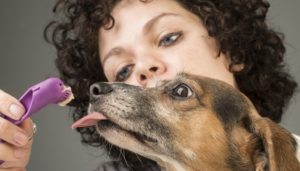 DO NOT use human dental care products on your dog!
DO NOT use human dental care products on your dog!
Tip: If you need tips on how to pick an appropriate toothbrush and toothpaste for your dog, read this guide and watch the accompanying step-by-step video from Samantha.
Ready to start? Begin by gently touching your dog’s gums with a clean finger. If your dog shows irritation or any signs of being uncomfortable, leave tooth brushing for another time. If your dog shows signs of being amenable to tooth brushing, put a small amount of dog-friendly toothpaste on your dog’s toothbrush.
Start by placing a finger and thumb on your dog’s top gum and pushing up their top lip. With a 45 degree angle, brush your dog’s teeth making sure to clean up to the gum line. Brush your dog’s teeth in small circles, just like you brush your own.
Move to the side of your dog’s mouth, holding their lip up one side at a time and brushing their teeth in circular motions. Consistently reassure your dog to make tooth brushing a pleasant experience.
Depending on your dog’s dental health, you may notice light bleeding as you brush your dog’s teeth. If you notice any more than light bleeding, however, consult your vet. Moderate to heavy bleeding may indicate a dental problem or a problem with your brushing technique.
You should brush your dog’s teeth daily to maintain good dog dental care and health routine. At a minimum, you should brush your dog’s teeth three times a week, according to veterinarians. Professional dog dental cleaning may also be recommended, and we'll get to that in a second.
RELATED VIDEO GUIDE: How To Brush A Dog's Teeth
3 The Importance of Tooth and Gum Stimulation
When it comes to dog dental care, stimulation of the pet's gums is what keeps the blood flowing to the teeth, thereby making them stronger and last longer. The first way to stimulate your dog's teeth and gums is through your regular dog dental care routine – brushing. But there are a few other ways that can add to that.
Dental Dog Toys
In addition to tooth brushing, your dog needs dental dog toys to stimulate their gums to prevent plaque buildup. There are many brand-name dental toys on the market, many of which may also help with additional dog dental cleaning procedures (without your intervention).
If you cannot find a dental toy that your dog can safely enjoy, your dog can get gum stimulation from bones.
Bones for Dogs
Bones are another safe way to stimulate your dog’s gums, but it’s important to purchase raw uncooked bones. These bones are sold as “soup bones” or “marrow bones”, just make sure to buy one large enough for your dog to chew safely.
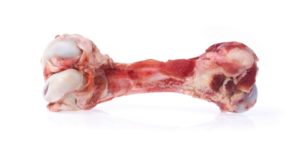 Raw bones can be messy, but they will not splinter like cooked, bleached, and sterilized bones. They are also less likely to break or chip your dog’s teeth. Just be sure to take the bone away from your dog when it is too small to safely chew.
Raw bones can be messy, but they will not splinter like cooked, bleached, and sterilized bones. They are also less likely to break or chip your dog’s teeth. Just be sure to take the bone away from your dog when it is too small to safely chew.
Other “bones” like rawhide can stimulate your dog’s gums. However, they contain unsafe ingredients, pose a choking hazard, and can block your dog’s intestines.
4 Professional Dog Dental Cleaning
Despite regular tooth brushing and gum stimulation, professional dog dental cleaning can help to remove stubborn gum line plaque. Catching gum line plaque early is important in preventing more serious dental problems like infection.
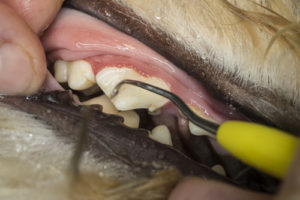 During a dental cleaning, which should be part of your regular dog dental care routine, your veterinarian will sedate your dog. They will then use a scaler to remove any plaque build-up. After removing build-up, your vet will then polish the tooth surface to prevent any rough patches that can make it easy for plaque to build-up on later.
During a dental cleaning, which should be part of your regular dog dental care routine, your veterinarian will sedate your dog. They will then use a scaler to remove any plaque build-up. After removing build-up, your vet will then polish the tooth surface to prevent any rough patches that can make it easy for plaque to build-up on later.
Your vet will also use a dog dental cleaning as an opportunity to check all of your dog’s teeth for chips, fractures, breaks, or infections. They will check your dog’s oral health at this time, too. Your vet should check your dog’s dental health every year at their annual checkup. A quick visual will determine if your dog needs a professional cleaning.
A regular brushing schedule and bones mean that your dog won’t need a professional cleaning every year, and that's simply a good dog dental care routine that we all should practice. On the other hand, a professional dog dental cleaning session every couple of years will help to eliminate any plaque buildup.
5 Other Canine Dental Health Products
Proper dog dental care means not only regular attendance to your pet's teeth but using the right type of dog dental cleaning supplies. While some pet owners fixate on the use of dog dental chews and toys that may or may not clean the dog's teeth (while the dental dog food remains a myth), the most effective way is to opt for specific tools and supplies for proper dog dental care.
Here are a few ideas:
Rinses
Just like in humans, dog dental cleaning rinses and dog dental water additives work similarly. They are sold in most pet stores and go directly into your dog’s water bowl. These water additives cut down plaque buildup with various cleansing ingredients like baking soda, chlorhexidine, and chlorine dioxide.
Wipes
Dental wipes for dogs are gentle abrasive wipes that you can use to wipe your dog’s teeth. Most often, these wipes use baking soda, parsley, and peppermint. They're a good dog dental cleaning solution but should not replace your dog's toothbrush and toothpaste.
Supplements
Dental supplements are plentiful but most often are powders that you sprinkle directly onto your dog’s food. These supplements include beneficial bacteria to maintain oral health as well as seaweed and kelp. They are rarely part of proper dog dental care routine, but adding them may help. Especially when things like fish oil for dogs has shown to improve many different health factors.
6 Risks to Your Dog’s Dental Health
Some items are potentially dangerous to your dog’s dental health because they pose a risk of chipping, breaking or fracturing teeth. What's even more dangerous is that some of these treats, toys and foods are even marketed as good for dog dental care or even dog dental cleaning, where in fact they are completely the opposite. Watch out for them.
Some of those items include:
- Nylon bones
- Sterilized or bleached bones
- Cooked “butcher” bones
When buying toys, make sure you pick only dog toys that are appropriate for your dog's age and size. Also, choose USA-made dog toys that are manufactured using good quality ingredients and by reputable companies rather than those imported from China.
RECOMMENDED: 6-Step Checklist for Fast & Effective Dog Teeth Brushing
Frequently Asked Questions
What else you must know about dog dental care and cleaning
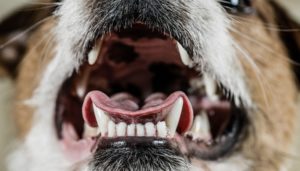 1. Do dogs get cavities?
1. Do dogs get cavities?
Very seldom. Dog’s teeth are more prone to cracking and chipping.
2. Do dogs regrow lost adult teeth?
No. Like us, dogs only get one set of adult teeth.
3. Why do I have to have baby teeth removed if my dog is older than 8 months?
Retained baby teeth cause problems because they create crowding in your dog’s jaw. Baby teeth and adult teeth are vying for limited space and causing the normal “blueprint” of your dog’s mouth to be shifted. This also creates many nooks for bacteria and plaque to hide and build up.
4. What is that huge tooth called?
The large tooth in your dog’s jaw is called a carnassial tooth. The carnassial tooth is a crushing tooth that dogs rely on to break and crush hard items like bone. The carnassial tooth has three roots.
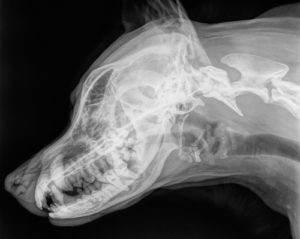 5. Does my dog have to have pre-cleaning x-rays?
5. Does my dog have to have pre-cleaning x-rays?
If your dog has annual dental cleanings, your vet may not require annual X-rays. X-rays are beneficial, though, because they can detect any dental problems under the gums or between teeth.
6. Why do small dogs have so much trouble with their teeth?
Smaller dogs have smaller jaws and frequently experience crowding of the teeth. This crowding creates more nooks for tartar buildup. Additionally, compared to larger dogs, smaller dogs have more fragile teeth that can chip or crack on hard surfaces.
7. Do dogs have to be anesthetized for a professional dental cleaning?
Yes! Anesthetization allows your vet to get a thorough look at all of your dog’s teeth and to clean any problem areas.
8. Isn’t anesthesia dangerous for my dog?
Pet owners often forego professional dental cleanings because they are afraid of the risks that anesthesia poses. Modern technology makes anesthesia a much safer process than it once was, so this worry is generally unwarranted.
There are some instances where anesthesia is risky, though; these include:
- Certain anesthesia is unsafe for dogs with heart disease or compromised heart function.
- Some breeds of dogs (particularly some collies) carry a gene that causes an adverse reaction to anesthesia. This gene can be tested with an MDR1 test.
- Dogs that show abnormalities in pre-anesthesia bloodwork that may indicate infection, illness, or serious disease.
READ MORE: The Truth – Is Anesthesia Safe for Dogs?
9. How much does a professional dental cleaning for dogs cost?
The cost of a dog’s dental cleaning varies based on the size of your dog, whether they need pre-anesthesia bloodwork, whether they need x-rays, the area of the country you live in, and your individual vet.
10. Do dogs get root canals or crowns?
Yes! Although not particularly common, dogs can undergo root canals and have crowns fitted. Most often, this is done when the carnassial tooth is compromised. For other teeth, pet owners usually choose extraction over a root canal/crown because of cost.
11. Do I really have to brush my dog’s teeth?
Yes… and no.
Brushing is important in removing plaque and bacteria so that it does not build up. Failure to brush your dog’s teeth makes it necessary to have more frequent professional cleanings and increases the chance of dental disease.
For dogs with severe anxiety or even aggression over teeth cleaning, it’s best to forego regular brushing. You can use dog dental bones and dental toys for dogs to promote consistent and proper dog dental care in your household and rely on professional dog dental cleaning for routine care instead.
READ NEXT: Dog Teeth Cleaning 101 – How to Clean Dogs' Teeth


